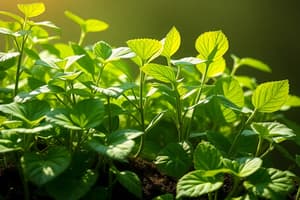Podcast
Questions and Answers
Which of the following organisms use simple food material obtained from inorganic sources in the form of carbon dioxide and water?
Which of the following organisms use simple food material obtained from inorganic sources in the form of carbon dioxide and water?
- Animals
- Fungi
- None of the above
- Green plants and bacteria (correct)
What is the internal energy reserve used by plants when required?
What is the internal energy reserve used by plants when required?
- Oxygen
- Carbohydrates (correct)
- Chlorophyll
- Water
What is the function of guard cells in photosynthesis?
What is the function of guard cells in photosynthesis?
- To convert light energy to chemical energy
- To absorb light energy by chlorophyll
- To regulate the opening and closing of stomatal pores (correct)
- To split water molecules into hydrogen and oxygen
Flashcards are hidden until you start studying
Study Notes
Nutrition and Photosynthesis in Living Organisms
- All organisms require energy and materials from outside sources, which they obtain through food.
- Autotrophs, such as green plants and bacteria, use simple food material obtained from inorganic sources in the form of carbon dioxide and water.
- Heterotrophs, such as animals and fungi, utilize complex substances that have to be broken down into simpler ones before they can be used for the upkeep and growth of the body.
- Photosynthesis is the process by which autotrophs take in substances from the outside and convert them into stored forms of energy.
- During photosynthesis, carbon dioxide and water are converted into carbohydrates in the presence of sunlight and chlorophyll.
- The carbohydrates which are not used immediately are stored in the form of starch, which serves as the internal energy reserve to be used as and when required by the plant.
- Chlorophyll is essential for photosynthesis; it is a cell organelle found in chloroplasts.
- Gaseous exchange for photosynthesis occurs through stomata, which are tiny pores present on the surface of the leaves, stems, and roots.
- The opening and closing of the stomatal pore is a function of the guard cells, which swell when water flows into them and shrink when water flows out.
- The process of photosynthesis involves the absorption of light energy by chlorophyll, conversion of light energy to chemical energy, splitting of water molecules into hydrogen and oxygen, and reduction of carbon dioxide to carbohydrates.
- Desert plants take up carbon dioxide at night and prepare an intermediate which is acted upon by the energy absorbed by the chlorophyll during the day.
- An experiment can be conducted to demonstrate that chlorophyll is essential for photosynthesis; two healthy potted plants are kept in a dark room for three days and then placed under separate bell jars, one with potassium hydroxide to absorb carbon dioxide and the other without.
Studying That Suits You
Use AI to generate personalized quizzes and flashcards to suit your learning preferences.




